Abstract
The competitive ability of weeds against crop plants is determined by the amount of macronutrients taken up from the soil. Macronutrient uptake is influenced by nutrient concentrations in plants and, above all, the amount of weed biomass produced per unit area. The present study was conducted as a part of a field experiment with winter oilseed rape, which has been carried out since 1967. Winter oilseed rape has been grown continuously since 1967 in the same field and in a six-field crop rotation. In winter oilseed rape monoculture, weed management was implemented to mitigate soil fatigue. Winter oilseed rape yields were twice as high in crop rotation than in monoculture, and weed biomass was more than three times higher in the continuous cropping system than in crop rotation. Winter oilseed rape yields were higher in crop rotation without a weed control than in monoculture, including monoculture with a weed control. Nitrogen (N) uptake by rape seeds and straw was significantly higher, whereas N uptake by weeds was lower in crop rotation than in monoculture. In all years of this study, N uptake by weed biomass was higher in monoculture than in crop rotation due to higher weed infestation levels in the continuous cropping system, and N uptake was not significantly affected by N content. The weed control induced a greater increase in N uptake by rape seeds and straw in monoculture than in crop rotation. The results indicate that integrating crop rotation with herbicide protection can help increase yields while reducing weeds, which promotes a more sustainable crop production system. The use of crop rotation contributes to a more efficient use of nitrogen by crops, while reducing its uptake by weeds.
1. Introduction
In addition to economic and organizational aspects, winter oilseed rape cultivation provides numerous agronomic and environmental benefits [1]. As demonstrated by Rathke et al. [2], the introduction of oilseed rape into crop rotation contributes to the improvement in soil structure, the increase in biological activity, and the reduction in pressure from pests and diseases. Winter oilseed rape can effectively compete with weeds due to its extensive root system and large amounts of high-quality residues. Sieling and Christen [3] observed that leaving a substantial amount of post-harvest residues with a high lignin and carbon content exerts an allelopathic effect on certain weed species, limiting their germination and growth. This crop species improves soil structure, and it can also break the life cycle of many pests, pathogens, and weeds [4,5,6]. In well-managed winter oilseed rape stands, weeds can be effectively controlled without excessive herbicide use [7]. Vykydalová and Kubík [8] confirmed that an integrated approach to oilseed rape cultivation management, considering habitat and biological factors, significantly reduces the need for chemical protection.
In Poland, unstable weather is a limiting factor in the production of winter oilseed rape [9]. Precipitation patterns that are not aligned with the specific needs of crops in different stages of growth can compromise their development and increase pressure from weeds [10]. Winter oilseed rape should be grown in soils that are abundant in plant-available nutrients [11]. This crop species has high environmental requirements [12], which means that low nutrient availability may significantly limit its development.
An adequate supply of macronutrients such as nitrogen (N), phosphorus (P), and potassium (K) is one of the greatest challenges in winter oilseed rape cultivation. Strong competition from weeds, especially in monoculture, can lead to nutrient depletion in soils, which directly decreases yields. Gradilă et al. [13] demonstrated that weeds uptake significant amounts of nitrogen and potassium, thereby reducing their availability to crop plants. Shahzad et al. [14] emphasized the benefits of crop rotation in limiting weed infestation and improving the efficiency of nutrient utilization, which enables crops to better compete for available resources.
Winter oilseed rape has a high demand for N, particularly in stages of rapid vegetative growth and seed development. Nitrogen is a key determinant of biomass growth and crop yields. Grant and Flaten [15] emphasized that the efficient use of nitrogen by oilseed rape depends not only on its availability in the soil but also on the reduction in competition from weeds. In monoculture, this competition is more intense, leading to decreased nitrogen uptake by the crop plants and reduced yields.
The detrimental effects of weeds are generally assessed based on the extent to which they decrease crop yields in weed-infested fields [16,17]. Saulic et al. [18] demonstrated that crop rotation, by increasing species diversity and changing crops, limits the development of specific weed species adapted to particular habitat conditions. Furthermore, Fang et al. [19] emphasized that crop rotation enhances the availability of macronutrients by improving the biological and chemical properties of the soil, thereby promoting better nutrient uptake by crop plants. Crop–weed competition is also determined by the amount of macronutrients taken up from the soil. Little et al. [17] demonstrated that nutrient uptake by weeds is strongly dependent on weed biomass per unit area, with high weed biomass resulting in a significant reduction in the availability of nitrogen and other macronutrients for crop plants.
Crop succession plays a key role in weed management, and it significantly improves nutrient cycling in soil. By diversifying crop species and local growing conditions, crop rotation suppresses weed growth [18] and increases plant nutrient availability [19]. According to Al-Shammary et al. [20], crop rotation decreases the dominance of perennial weeds and stimulates the activity of soil-dwelling microorganisms, which increases N use efficiency in winter oilseed rape. Oilseed rape monoculture promotes the accumulation of crop residues and increases competitive pressure from weeds [21,22]. Gawęda et al. [23] observed that some monocotyledonous and dicotyledonous weeds can dominate in monocultures and decrease the availability of soil N to crops. Weeds are often able to absorb nutrients from the soil more effectively than crop plants. Gaba et al. [24] demonstrated that many weed species, including Capsella bursa-pastoris and Stellaria media, are characterized by higher growth rates and higher N uptake efficiency than winter oilseed rape.
Crop protection should involve an integrated approach that combines biological, biotechnological, chemical, physical, and breeding methods. Chemical plant protection products should be used only when absolutely necessary and economically justified [25]. According to Zheng et al. [26] and Akhatar et al. [27], farmers following the principles of integrated crop protection should be familiar with the key challenges associated with winter oilseed rape production. Agricultural producers should be well versed in the biology of pathogens, pests, and weeds to control them effectively when they exceed economic threshold levels.
In studies on the interaction between soil, crops, and weeds, the use of data derived from long-term field experiments is of paramount importance. Short-term observations often fail to capture the complex and cumulative effects of environmental interactions as well as changes occurring in weed biomass and soil resource dynamics [24,28]. Therefore, the following research hypotheses were formulated: the cultivation of winter oilseed rape in crop rotation increases yield, reduces weed infestation, and affects nitrogen removal with both crops and weeds; additionally, plant protection in winter oilseed rape cultivation increases yield, reduces weed infestation, and alters nitrogen removal with crops and weeds.
The aim of this study was to determine the effect of long-term monoculture and crop rotation on winter oilseed rape yields, weed infestation, and nitrogen uptake by the crop plant and weeds. Most studies exploring the impact of continuous cropping on crop yields and weed infestation have analyzed the relationship between crop yields and weed biomass, but the harmful impacts of weeds have never been examined in the context of soil nutrient depletion. These relationships should be examined not only to reduce weed infestation levels, but also to highlight the importance of environmental factors in developing sustainable agricultural practices.
2. Materials and Methods
2.1. Experimental Conditions
This study was conducted in an experimental field where winter oilseed rape has been grown since 1967 in a continuous cropping system (monoculture) and in a six-year crop rotation. The present results were obtained during winter oilseed rape cultivation in 2019–2022. The experiment was established in the Agricultural Experiment Station in Bałcyny, Poland (53.60° N, 19.85° E). The agronomic treatments applied in winter oilseed rape cultivation were consistent with the standards developed for a medium-input production technology (Table 1).

Table 1.
Description of agronomic treatments and the main growth stages of winter oilseed rape.
2.2. Weather Conditions
During this study, temperatures exceeded the long-term average (1981–2015) (Figure 1). Above-average temperatures in August and September of the 2020/2021 season could have contributed to the rapid growth of weeds, which compete with oilseed rape for water and nutrients in warm periods. In the 2021/2022 growing season, September and October were somewhat cooler months, which probably slowed down the emergence of oilseed rape plants and their development before winter. Higher temperatures in the winter of 2019/2020 could have promoted the early mineralization of nutrients and could have prolonged the growing season of winter oilseed rape. In the 2021/2022 season, the minimum temperature in December reached −2.2 °C, which probably partly inhibited the growth of oilseed rape plants and increased their susceptibility to freeze stress. During this study, spring temperatures were somewhat below the long-term average (1981–2015). Lower temperatures probably slowed down biomass growth and mineral uptake by oilseed rape plants. In most years, May and June temperatures exceeded the long-term average, which probably accelerated plant ripening and shortened the period during which biomass and nutrients were accumulated by winter oilseed rape.

Figure 1.
Monthly temperatures [°C] in the growing seasons of 2019–2022 relative to the long-term average (1981–2015).
In the 2021/2022 season, high precipitation in August (147.4 mm) could have promoted the emergence of oilseed rape plants (Figure 2). Rainfall levels in September were below the long-term average in all growing seasons, which probably limited seedling emergence. In the 2020/2021 season, October was a very wet month (81.2 mm), which probably promoted rapid weed growth and increased the risk of fungal diseases. In the 2021/2022 season, high precipitation in January and February (40.7 mm and 57.6 mm, respectively) could have contributed to an increased water supply in spring. The winter of 2020/2021 was relatively dry, which decreased water availability before the period of rapid plant growth. April was a very dry month in 2020 and 2021 (1.1 mm and 0.0 mm, respectively), which probably slowed down plant growth and nutrient uptake.
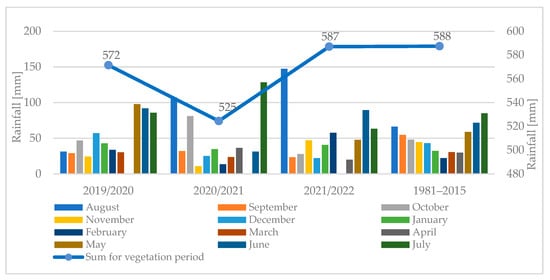
Figure 2.
Monthly rainfall [mm] in the growing seasons of 2019–2022 relative to the long-term average (1981–2015).
2.3. Soil
Winter oilseed rape was grown in soil developed from boulder clay, glacial sand, and gravel, which principally formed during the last glacial cycle. According to the World Reference Base for Soil Resources, this soil profile corresponds to Haplic Cambisol. The experimental plots were located on a gently undulating terrain. An analysis conducted before the experiment (2019) revealed that soil had a slightly acidic pH (5.7, measured in a KCl solution) and contained Corganic—10.7–11.5 g kg−1, Ntotal—0.70–0.90 g kg, P—86.0–90.0 mg kg−1, K—165.0–175.1 mg kg−1, Mg—69.8–75.4 mg kg−1, and Mn—155.0–166.8 mg kg−1.
2.4. Experimental Design
The long-term, small-area field experiment had a split-block design with three replications (Figure 3). Twelve crops were grown in the experiment in monoculture and two six-field rotations. A total of twenty-four fields were separated—one for continuous cropping (CC) and crop rotation (CR) of each species; the area of each plot is 27 m2; the total area of the experiment is about 1 hectare. The experimental factors were as follows:
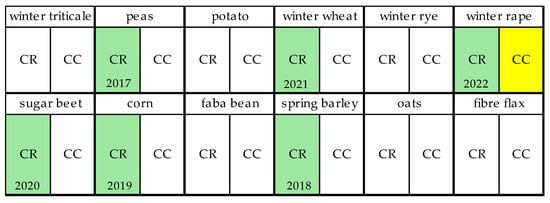
Figure 3.
Distribution of plots in the experimental field. 2017, 2018, 2019, 2020, 2021, 2022—years in which winter oilseed rape was grown in the experimental field in crop rotation. CR—crop rotation, CC—continuous cropping. Green color—location of winter oilseed rape field in crop rotation, yellow color—location of winter oilseed rape in continuous cropping.
- I.
- Crop succession system:
- (a)
- winter oilseed rape grown in a six-field crop rotation: sugar beets, maize, spring barley, peas, winter oilseed rape, and winter wheat;
- (b)
- winter oilseed rape grown in a continuous cropping system (monoculture).
- II.
- Crop protection:
- (a)
- without herbicide application;
- (b)
- with herbicide application (the applied herbicides are listed in Table 2).
 Table 2. Crop protection products applied in plots with weed control (the same products were used in crop rotation and monoculture).
Table 2. Crop protection products applied in plots with weed control (the same products were used in crop rotation and monoculture).
The selection of specific herbicidal products in individual growing seasons of winter oilseed rape was based on the need to adapt the crop protection strategy to prevailing weather conditions, sowing dates, and anticipated weed pressure. In the 2019/2020 season, the herbicide Butinas Avant was applied, containing three active substances: metazachlor, dimethenamid-P, and quinmerac. This combination ensured a broad spectrum of activity and high efficacy under potentially limited soil moisture conditions, which was particularly important due to the very early application date. In the following seasons (2020/2021 and 2021/2022), Butisan Star 416 S.C. was used, containing metazachlor and quinmerac. The exclusion of dimethenamid-P may have resulted from more favorable soil moisture conditions at the time of sowing, as well as the aim to optimize the cost of herbicide protection while maintaining the effective control of key weed species, including both grass and broadleaf weeds.
2.5. Sampling and Analysis
2.5.1. Determination of Weed Species and Harvested Biomass (Weed Biomass, Winter Oilseed Rape Seed, and Straw Yields)
In each year of this study, the species composition of weeds was determined over an area of 0.5 m–2 in the flowering stage of winter oilseed rape (BBCH 60–65), and weeds were removed together with the root system. The roots were cut off, and weeds were left to dry in the air. Dry weeds were weighed on a WTC 2000 scale (Radwag, Radom, Poland). The moisture content of dry weeds was measured with a Wile 500-S moisture meter (Farmcomp Oy, Tuusula, Finland), and the result was used to convert weed dry matter to a moisture basis of 15%. Rape seeds and straw were harvested with a plot harvester (Wintersteiger Classic 1540, Wintersteiger, Ried im Innkreis, Austria). The moisture content of the harvested seeds and straw was measured with a GMS v2 moisture meter (Dramiński, Gietrzwałd, Poland), and the result was used to convert dry matter to a moisture basis of 15%. The harvested weeds, seeds, and straw were used to calculate the biomass produced per hectare.
2.5.2. Determination of Total Nitrogen in Plant Material and Soil
The total N content of winter oilseed rape, weeds, and soil was determined. Weeds collected at the flowering stage of winter oilseed rape (BBCH 60–65), after species identification and weighing, were air-dried at room temperature. Once dried, the weeds were mixed and cut into small pieces. The oilseed rape seeds were also air-dried at room temperature and packed in 0.5 kg portions from each plot. The harvested winter oilseed rape straw was transported to the laboratory in quantities of 5 kg per plot, then cut into small pieces and air-dried at room temperature. Subsequently, the straw was packed in 0.5 kg portions from each plot. Soil samples were collected immediately after the harvest of winter oilseed rape. The soil was sampled using a manual auger (Egner’s soil sampler) from the arable layer at a depth of 0–25 cm. Sampling was conducted at evenly distributed points within each plot. Approximately 1 kg of soil was collected from each plot. The collected soil material was air-dried at room temperature and sieved to remove plant residues. Approximately 0.5 kg of the prepared soil was then packed. Samples of seeds, straw, weeds, and soil were submitted to an accredited laboratory at the Chemical and Agricultural Station in Olsztyn (accreditation certificate No. AB 277 issued by the Polish Centre for Accreditation in Warsaw). Dry plant material was ground in a GM 300 laboratory mill (Retsch, Haan, Germany), and soil samples were dried and passed through a sieve with 1 mm mesh size. To determine the N content, the samples were mineralized in H2SO4 as the oxidizing agent with the addition of K2SO4 and CuSO4 (the samples were mineralized until white smoke was no longer produced and a clear green solution was obtained). Nitrogen was determined by the Kjedahl method in the KjelFlex K-360 distillation unit (Buchi, Flawil, Switzerland).
2.5.3. Determination of Nitrogen Uptake by Plants
Nitrogen uptake by rape seeds, straw, and weeds was determined in kg N ha−1 using the following formula:
Relative differences were calculated with the formula below:
2.6. Statistical Analysis
The results of the experiment were processed statistically using descriptive statistics and a three-way analysis of variance (ANOVA). The independent variables considered were as follows: year of cultivation, crop succession system, and plant protection. Homogeneous groups were identified by Tukey’s test (p ≤ 0.5). Additionally, a principal component analysis (PCA) was performed, involving the derivation of entirely new variables that are linear combinations of the observed (original) variables. Data were processed in the TIBCO Statistica PL v.13.3 (TIBCO Inc., Krakow, Poland) program at a significance level of α = 0.05.
3. Results
3.1. Weed Species Composition
The weed species composition was similar in all years of this study. The weed species identified during three years of winter oilseed rape cultivation (not grouped by years) are listed in Table 3. Only minor differences in weed species composition were observed between the examined crop succession systems. Weed species such as Centauria cyanus, Agropyron repens, Geranium pusillum, Stellaria media, Matricaria maritima, Poa trivialis, and Viola arvensis were identified in both crop rotation and monoculture. Anthemis arvensis, Apera spica-venti, Cirsium arvense, Capsella bursa-pastoris, and Veronica arvensis were identified only in the continuous cropping system. In the crop rotation system, twelve weed species were identified, while in the continuous cropping system, eleven species were recorded, five of which occurred exclusively in continuous cropping. The total number of weed individuals amounted to 37.21 plants m2 in crop rotation and as much as 84.01 plants m2 in continuous cropping, indicating a significantly higher weed infestation under continuous cropping. Similarly, the total air-dried weed biomass was considerably greater in continuous cropping—187.60 g m2 compared to 47.70 g m2 in crop rotation. In the continuous cropping system, the highest contribution to weed biomass was observed for Centaurea cyanus, Stellaria media, and Anthemis arvensis. In contrast, under crop rotation, weed biomass was lower and more evenly distributed among the species.

Table 3.
Weed species identified over a period of three years.
3.2. Seed and Straw Yields and Weed Biomass
The results presented in Table 4 indicate that the crop rotation system had a significant effect on both the yield of winter oilseed rape and weed biomass. Crop protection had no effect on crop yield; however, a substantial reduction in weed biomass was observed following herbicide application. Throughout the three-year study period, significant inter-annual differences were recorded in both crop yield and weed biomass.

Table 4.
Winter oilseed rape seed and straw yields and weed biomass (mean ± standard deviation).
Rape seed and straw yields and weed biomass were significantly influenced by the year of study and the crop succession system (Figure 4). The significantly highest rape seed (2395 kg ha–1) and straw (3807 kg ha–1) yields were noted in 2022, whereas weed biomass was significantly highest (1423 kg ha–1) in 2020. Rape seed (1695 kg ha–1) and straw (2871 kg ha–1) yields and weed biomass (776 kg ha–1) were significantly lowest in 2021. Significantly higher rape seed (by 108%) and straw (by 98%) yields were noted in crop rotation than in monoculture. In contrast, weed biomass was higher (by 293%) in monoculture than in crop rotation.

Figure 4.
The effect of year (a), crop succession system (b), and crop protection (c) on winter oilseed rape seed and straw yields and weed biomass, 2020–2022, kg ha–1. Values followed by the same letters do not differ significantly in Tukey’s (HSD) test (p < 0.05).
Rape seed and straw yields were significantly influenced by the year × crop succession system × crop protection interaction (Figure 5). In all years of this study, this interaction contributed to the greatest increase in rape seed and straw yields in crop rotation. In winter oilseed rape grown in monoculture, herbicides reduced weed infestation by 32% on average relative to unprotected plots but weed infestation levels remained several times higher than in unprotected plots in crop rotation.

Figure 5.
The effects of the interaction between year, crop succession system, and crop protection on winter oilseed rape seed and straw yields and weed biomass, 2020–2022, kg ha–1. Values followed by the same letters do not differ significantly in Tukey’s (HSD) test (p < 0.05).
In comparison with monoculture, crop rotation was more effective in suppressing weeds in treatments without herbicide application (rape seed and straw yields increased by 151.1% and 131.8%, respectively) than in treatments where herbicides were applied (increase of 90.1% and 86.4%, respectively) (Figure 6). In crop rotation, weed infestation was reduced by 75% on average at both levels of crop protection, compared to monoculture.
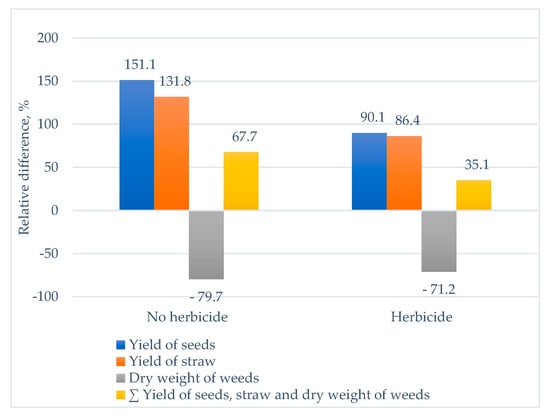
Figure 6.
Relative difference in winter oilseed rape seed and straw yields and weed biomass between crop rotation and continuous cropping, %, average for 2020–2022 (monoculture is assumed to be 100%).
3.3. Nitrogen Content of Plant Material (Seeds, Straw, and Weeds)
The N content of rape seeds, straw, and weeds differed significantly across years of this study (Figure 7). Rape seeds were most abundant in N in 2021 (2.61 g kg–1) and 2022 (2.49 g kg–1), whereas the N content of weeds was highest in 2022 (1.94 g kg–1). The N content of plant material was not significantly differentiated by the crop succession system or crop protection levels.
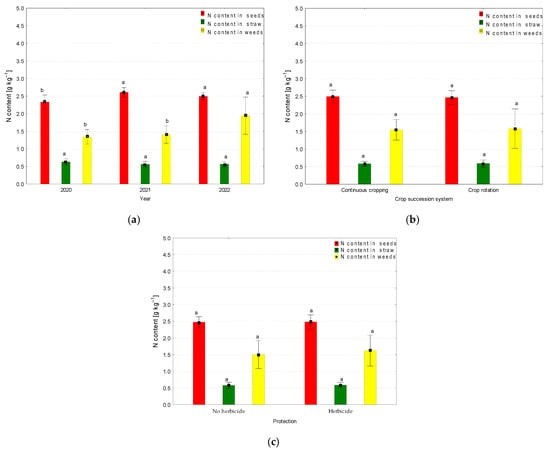
Figure 7.
The effect of year (a), crop succession system (b), and crop protection (c) on the N content of winter oilseed rape seeds, straw, and weeds, 2020–2022, g kg–1. Values followed by the same letters do not differ significantly in Tukey’s (HSD) test (p < 0.05).
The N content of seeds was not significantly modified by the year × crop succession system × crop protection interaction. However, the N content of seeds was lowest in crop rotation with herbicide application in 2020 and highest in monoculture with herbicide application in 2021 (Figure 8). The N content of weeds was highest in crop rotation with herbicide application in 2022, and this result contributed to high N levels in total biomass.
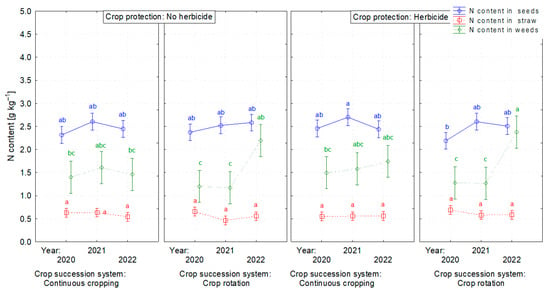
Figure 8.
The effect of the interaction between year, crop succession system, and crop protection on the N content of winter oilseed rape seeds, straw, and weeds, 2020–2022, g kg–1. Values followed by the same letters do not differ significantly in Tukey’s (HSD) test (p < 0.05).
The weed control exerted different effects on the N content of plant material. Herbicides increased N levels in rape straw and weeds but decreased the N content of rape seeds (Figure 9).
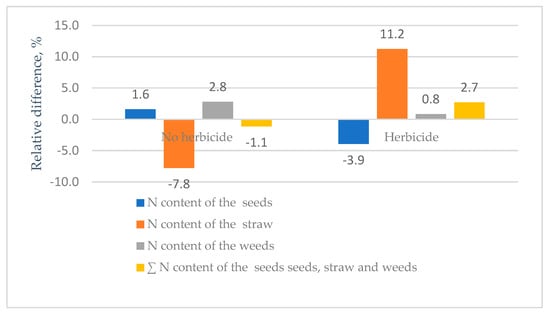
Figure 9.
Relative difference in the N content of winter oilseed rape seeds, straw, and weeds between crop rotation and continuous cropping, % (average for 2020–2022) (monoculture is assumed to be 100%).
3.4. Nitrogen Uptake
In the monoculture system, a markedly lower nitrogen uptake in the seed and straw yield was observed, whilst nitrogen uptake by biomass weeds remained high (Table 5). Herbicide application and the year of study had no significant effect on nitrogen uptake by either winter oilseed rape or weeds.

Table 5.
Nitrogen uptake with winter oilseed rape seed and straw yields and weed biomass (mean ± standard deviation).
Nitrogen uptake by rape seeds, straw, and weeds differed significantly between the compared crop succession systems (Figure 10). The observed differences in rape yields and weed biomass confirm the significant influence of the crop succession system. In crop rotation, N uptake by rape seeds and straw was significantly higher (by 101% and 107%, respectively), whereas N uptake by weeds was lower (by 73%) than in monoculture.
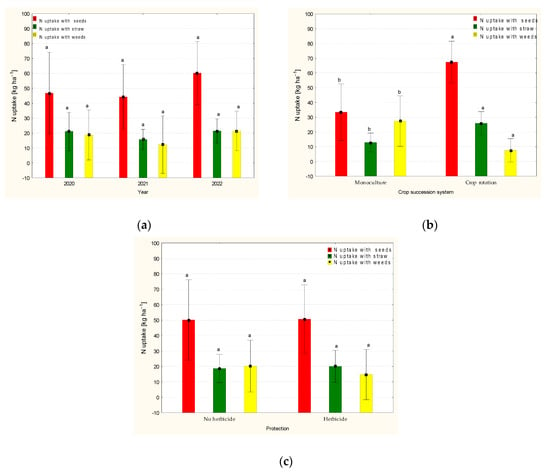
Figure 10.
The effect of the interaction between year (a), crop succession system (b), and crop protection (c) on N uptake by winter oilseed rape seeds, straw, and weeds, 2020–2022, g kg–1. Values followed by the same letters do not differ significantly in Tukey’s (HSD) test (p < 0.05).
Nitrogen uptake by rape seeds, straw, and weeds was not significantly affected by the year × crop succession system × crop protection interaction (Figure 11). The weed control induced a greater increase in N uptake by rape seeds and straw in monoculture than in crop rotation. Nitrogen uptake by weeds was higher in monoculture than in crop rotation in all years of this study. As previously noted, the above resulted mainly from higher weed infestation levels in the continuous cropping system, and N uptake was not significantly affected by N content.
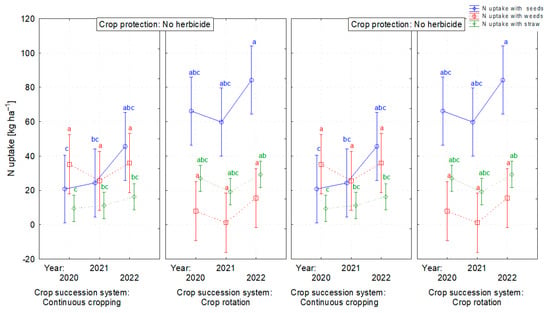
Figure 11.
The effect of the interaction between year, crop succession system, and crop protection on N uptake by winter oilseed rape seeds, straw, and weeds, 2020–2022, g kg–1. Values followed by the same letters do not differ significantly in Tukey’s (HSD) test (p < 0.05).
At both levels of crop protection, the effect of crop rotation on N uptake by rape seeds, straw, and weeds, relative to monoculture, was similar to that noted in the analysis of yields (Figure 12).
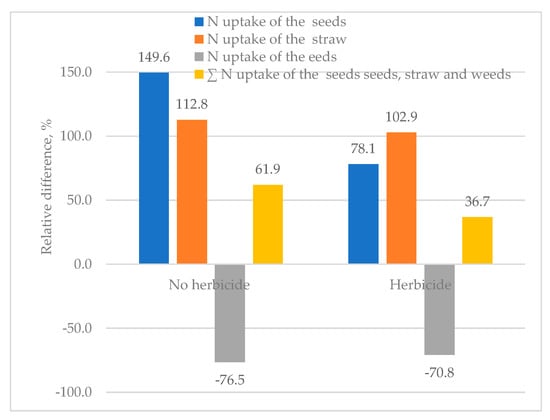
Figure 12.
Relative difference in N uptake by winter oilseed rape seeds, straw, and weeds between crop rotation and continuous cropping, % (average for 2020–2022) (monoculture is assumed to be 100%).
3.5. Nitrogen Content of Soil
The N content of soil was not affected by year, herbicide application, or the year × crop succession system × crop protection interaction (Figure 13 and Figure 14). The N content of soil was significantly higher in monoculture (by 21.5%) than in crop rotation. In 2021 and 2022, the weed control had no effect on soil N levels in crop rotation relative to monoculture (Figure 15). In 2020, the absence of a weed control induced a greater decrease in the N content of soil in crop rotation than in monoculture.

Figure 13.
The effect of year (a), crop succession system (b), and crop protection (c) on the N content of soil (average for 2020–2022), g kg–1. Values followed by the same letters do not differ significantly in Tukey’s (HSD) test (p < 0.05).
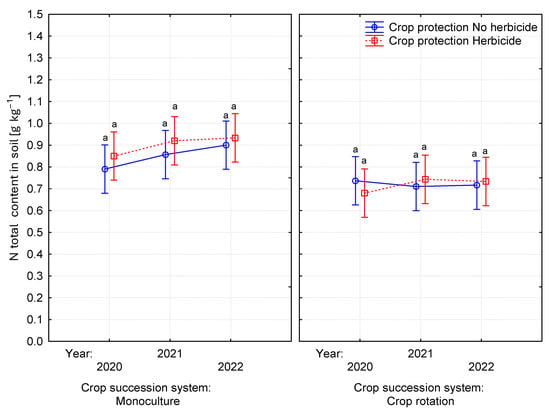
Figure 14.
The effect of the interaction between year, crop succession system, and crop protection on the N content of soil (average for 2020–2022), g kg–1. Values followed by the same letters do not differ significantly in Tukey’s (HSD) test (p < 0.05).
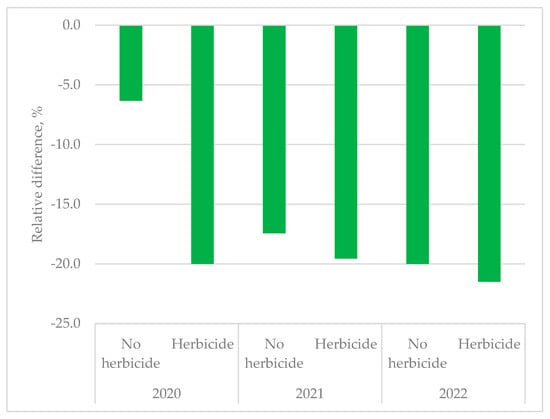
Figure 15.
Relative difference in the N content of soil between crop rotation and continuous cropping, % (average for 2020–2022) (monoculture is assumed to be 100%).
3.6. Principal Component Analysis (PCA)
The results of the principal component analysis, represented by the first two components, show that PC1 and PC2 account for 56.83% and 20.58% of the variance, respectively, totaling 77.41% of the overall variance of the original variables. The vectors representing the original variables (Figure 16) mostly reach the edges of the unit circle, indicating a good representation by the first two components forming the coordinate system.
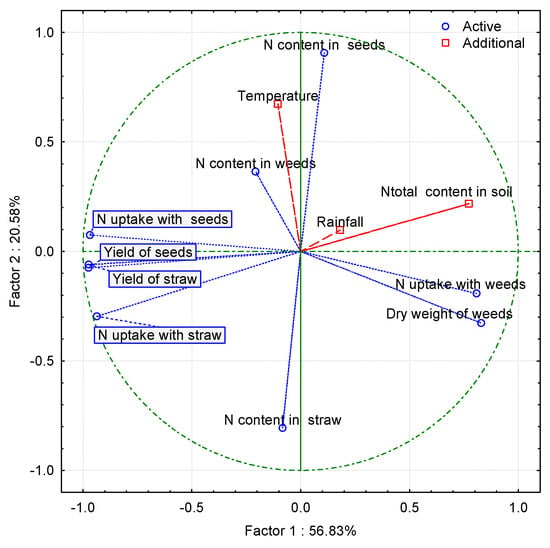
Figure 16.
The results of the PCA exploring the effect of temperature, rainfall, N content of seeds, straw and weeds, seed and straw yields, weed biomass, and N content of soil on N uptake by seeds, straw, and weeds.
The principal component analysis (PCA) revealed a strong positive correlation between seed yield, straw yield, N uptake by seeds, and N uptake by straw. A strong correlation was also observed between weed biomass and N uptake by weeds. Seed yield, straw yield, N uptake by seeds, and N uptake by straw were negatively correlated with the N content of soil, N uptake by weeds, and weed biomass. Temperature and rainfall are located close to the center of the PCA plot, but these variables are projected in opposite directions. The data presented in Figure 17 represent individual cases of oilseed rape cultivation variants in respective growing years, with the distance between them indicating the similarity in cultivation practices across the years. These variants can be divided into two groups based on the crop succession system, i.e., crop rotation or monoculture, regardless of the weed control. The results noted in the crop rotation system in 2020, both with and without herbicide application, constitute the only exception.

Figure 17.
Projection of variables and treatments onto the first and second principal components.
4. Discussion
Agricultural intensification has led to the widespread use of chemical weed controls, thus undermining the significance of sustainable weed management practices [7]. The competitive ability of crops can be enhanced through crop rotation, sustainable fertilization, and the development of new crop protection strategies involving herbicides [29,30,31] to maintain sustainable and highly productive agroecosystems.
In the present study, only minor differences in weed species composition were observed between the examined crop succession systems. Most weed species were identified in both crop rotation and monoculture, which indicates that they are well adapted to the local environmental conditions and different agricultural practices [32]. This study was conducted on a site with stabilized habitat conditions and a long history of agricultural use, which may have limited the effect of crop succession changes on the floristic composition of weed infestation. Crop rotation increases the diversity of weed species by inducing more dynamic changes in habitat conditions [33]. Crop rotation can lead to greater weed seed bank depletion than simple crop succession [34]. According to Rasmussen et al. [35] and Choudhary [36], effective weed suppression is the main phytosanitary factor that improves crop and soil productivity in crop rotation systems [14,29]. Crop rotation plays a key role in weed management, and it is a comprehensive strategy for protecting and increasing crop yields [37,38,39,40].
The differences observed in the PCA analysis are a direct reflection of the variability in habitat conditions and the selective weed pressure associated with the two management systems. The coherence and distinctiveness of the monoculture stem from its predictability, whereas the variability and dispersion of the crop rotation data indicate dynamically changing environmental conditions that restrict the dominance of specific weed species.
Temperature and rainfall exert both direct and indirect effects on yield formation processes in different stages of plant growth [22,41,42]. In the 2021/2022 growing season, high precipitation in late winter increased water availability in spring, increased yields, and probably influenced the mineralization of harvest residues in soil [43]. In the 2020/2021 season, low precipitation in winter and spring led to low water availability during yield formation. According to Takashima et al. [41], low precipitation during the growing season and below-zero temperatures during flowering are the key factors that decrease yields in both winter and spring rape seed cultivars. Champolivier and Merrien [44] observed that the water deficit between flowering and seed development decreases rape seed yields. Drebenstedt et al. [45] reported on the long-term effect of precipitation on leaf size, leaf senescence, and biomass allocation. In a later study, Drebenstedt et al. [46] also found that higher cumulative precipitation increased above-ground biomass and seed yield.
In oilseed rape production, seed yield is influenced by the interaction between cultivar, soil, weather, and farming intensity [29]. The high yields obtained in 2022 were the result of favorable moisture conditions, particularly abundant precipitation at the turn of winter and spring, which improved water availability to plants during critical growth stages for yield formation. Increased soil moisture may have accelerated the mineralization of post-harvest residues, thereby enhancing the availability of nutrients. In contrast, the lower yields recorded in 2021 were due to limited water resources during the winter–spring period, which may have disrupted plant development, especially during flowering and seed setting. In the current study, rape seed and straw yields were higher in crop rotation than in monoculture. Diverse preceding crops in the rotation with winter oilseed rape help prevent the unilateral depletion of water and nutrient resources, while also limiting the development of specialized pests and pathogens. Butkevičienė et al. [22] also found that long-term crop rotation can increase crop productivity and reduce weed prevalence and the weed seed bank in soil. In the work of Zhao et al. [47], crop rotation increased yields by 20% compared to continuous monoculture. Research has shown that the impact of crop rotation on yields remains relatively stable or even increases with repeated rotations due to the positive cumulative effects of crop rotation and the negative cumulative effects of monoculture [48]. The effect of multiple crop rotation sequences on yields can differ significantly across years, which indicates that some pre-crops can decrease the yields of subsequent crops [47]. However, the negative impact of crop rotation is observed only during dry spells, when soil water is depleted by pre-crops [49].
In this study, weed biomass was higher in the winter oilseed rape monoculture than in crop rotation. Weeds respond rapidly to changes in resource availability, and due to their diverse gene pool and greater physiological plasticity, they are likely to show better adaptation and greater resilience to environmental changes than crops [50,51]. Contemporary crop structures are dominated by cereals and other locally produced crops [52], which increases weed pressure [22]. Agricultural systems that do not rely solely on intensive herbicide use but combine diversified crop rotations with various weed control strategies are able to increase the diversity of weed communities and reconcile long-term weed management with high crop productivity [53]. Crop rotation disrupts the life cycle of weeds, thus preventing them from proliferating and adapting to the local agroecological conditions [39].
Milberg and Hallgren [54] demonstrated that weed pressure can decrease crop yields by as much as 31%, even if herbicides are used. They also found that herbicides modify the species composition of weeds and that yield losses are nearly always caused by weed dominance. In the present study, weed control in monoculture did not compensate for the negative consequences of inadequate crop succession. It is important to consider the role of chemical protection—within the crop rotation system, herbicide rotation was easier to implement, which may have reduced the selective pressure on weed populations. In comparison with monoculture, crop rotation was more effective in suppressing weed treatments without herbicide applications than in treatments where herbicides were applied. Intensive and inappropriate herbicide use can negatively affect agroecosystems and contribute to the development of herbicide-resistant weed biotypes [55]. The chemical weed control combined with crop rotation could be a viable solution for sustainable weed management [56,57].
Some authors [29,37,58,59] emphasized the importance of crop rotation for achieving high winter oilseed rape seed yields, high oil yields, increasing N use efficiency, and decreasing N rates. In the current study, the N content of plant material was not significantly differentiated by the crop succession system or weed control. The crop succession system significantly influenced N uptake by biomass, mainly due to the interaction effect exerted by the experimental factors on yields. This phenomenon indicates that the nitrogen content in plant dry matter is relatively stable and is determined primarily by the physiological characteristics of the plants, whereas the amount of nitrogen taken up from the soil depends on the biomass production, as also confirmed by the findings of Hegewald et al. [37]. In the work of Wang et al. [60], increasing N rates enhanced the competitive ability of oilseed rape against weeds due to a much higher sensitivity to the N supply.
Zhao et al. [47] found that the impact of crop rotation on yields was determined by the soil’s total N content. The knowledge of the N supply in soil and its mineralization potential, combined with the understanding of weed–crop competition in response to soil nutrient levels, can be used to optimize N rates and enhance the competitive ability of different crop species [61]. Weeds compete with crops for light, water, and nutrients [52,53]. Weeds reduce crop yields to a greater extent when crops and weeds utilize shared nutrient resources at the same time [62].
According to McDaniel et al. [63], crop rotation promotes the diversity of harvest residues in the field, which increases soil fertility and yields. Franke et al. [64] observed that legume residues are more abundant in N and have a lower C/N ratio than cereal residues; therefore, they are rapidly decomposed and release N for successive crops. In oilseed rape cultivation, high soil N levels contribute to the competitive ability of crops against weeds, whereas a low N supply can delay canopy closure, thus decreasing the potential of weed suppression [2,65]. In the work of Hu et al. [66], herbicides considerably increased N uptake by oilseed rape plants after flowering. Nitrogen accumulation by weeds also increased in response to N supply, but to a lesser degree.
In the present study, the N content of soil was higher in the winter oilseed rape monoculture than in crop rotation. Higher soil N levels can promote weed growth, but this relationship is not very strong [67,68]. The above effect can be modified by other factors, such as herbicide application and crop–weed competition. The content of mineral N in soil is higher in long-term crop rotation than in simplified systems [69]. Rapid growth combined with high N uptake makes weed plants more susceptible to changes in nutrient availability [70,71]. In this study, high weed biomass in monoculture and crop rotation without weed control was converted into a soil N source. However, this source has never been efficiently utilized, in contrast to the N taken up by plants.
In the current study, the soil’s total N content was negatively correlated with rape seed yield. The presence and distribution of weed biomass, particularly in plots not treated with herbicides, may have contributed to a temporary increase in the mineral nitrogen content in the soil as a result of the mineralization of dead organic matter. High soil N levels do not always result in high yields. This fact may be attributed to the inefficient utilization of N supplied with fertilizers, which compromises plant growth and increases susceptibility to weeds, pests, and pathogens [72]. In addition, under unfavorable environmental conditions, N is not always effectively absorbed by plants and does not lead to an increase crop yields [73]. A negative correlation between soil N content and crop yields can be attributed to increased weed pressure, inadequate N use efficiency, or other environmental constraints [2]. At the same time, it was observed that straw yield was positively correlated with soil N content. This phenomenon is typical in situations where an excess of nitrogen stimulates vegetative growth (stems, leaves) at the expense of the development of generative organs (seeds). The positive correlation between the soil nitrogen (N) content and the straw yield of oilseed rape, accompanied by a negative correlation with the seed yield, is well documented in the scientific literature [2,12]. Precipitation is positively correlated with the N content of soil. Precipitation increases the soil’s moisture content, which enhances the activity of soil-dwelling microorganisms responsible for mineralization and nitrification processes [74]. The above conditions are conducive to the rapid decomposition of soil organic matter and the release of plant-available N. Higher precipitation levels promote the growth of both crops and weeds, thereby increasing biomass production. Harvest residues undergo decomposition, thus enriching soil with N [44].
5. Conclusions
The impact of crop succession systems and crop protection levels on crop yields and weed infestation was strongly influenced by weather conditions during the study years. Winter oilseed rape yielded significantly better in crop rotation than in monoculture—the yields were twice as high in the crop rotation system. Even without a weed control, winter oilseed rape yields in rotation were higher than those in continuous cropping, including treatments where a weed control was applied. Moreover, in crop rotation, the yields were similar regardless of whether a weed control was used or not, indicating a weaker dependence on herbicide application. Weed biomass was over three times higher in continuous cropping than in crop rotation. This resulted in significantly higher nitrogen uptake by weeds in monoculture across all study years. In contrast, N uptake by rape seeds and straw was significantly higher in crop rotation. This suggests more efficient nutrient use by the crop in rotation compared to continuous cropping. The weed control improved N uptake by rape seeds and straw more noticeably in monoculture than in crop rotation. This is likely due to the weaker effect of crop protection on seed and straw yields in the rotation system, where the natural suppression of weeds was more effective. However, the N content of rape seeds and straw was only slightly affected by the level of crop protection. The principal component analysis (PCA) clearly distinguished between crop rotation and monoculture systems. The continuous cropping data formed more cohesive clusters and indicated different grouping patterns compared to crop rotation, further highlighting the contrasting dynamics of the two systems. These results support the adoption of sustainable crop management practices that reduce dependence on herbicides while maintaining productivity.
Author Contributions
Conceptualization, A.S.; methodology, A.S. and E.K.; validation, A.S., K.W. and E.K.; formal analysis, A.S., K.W. and E.K.; investigation, A.S.; resources, A.S.; writing—original draft preparation, A.S., K.W. and E.K.; writing—review and editing, A.S. and K.W.; visualization, A.S. and E.K.; supervision, A.S. and K.W.; project administration, A.S.; funding acquisition, A.S., K.W. and E.K. All authors have read and agreed to the published version of the manuscript.
Funding
The results presented in this paper were obtained as part of a comprehensive study financed by the University of Warmia and Mazury in Olsztyn, Faculty of Agriculture and Forestry, grant number 30.610.015-110.
Institutional Review Board Statement
Not applicable.
Informed Consent Statement
Not applicable.
Data Availability Statement
The data presented in this study are available on request from the corresponding author.
Conflicts of Interest
The authors declare no conflicts of interest. The funders had no role in the design of the study; in the collection, analyses, or interpretation of data; in the writing of the manuscript; or in the decision to publish the results.
References
- Marcińska-Mazur, L.; Mierzwa-Hersztek, M. Enhancing productivity and technological quality of wheat and oilseed rape through diverse fertilization practices—An overview. J. Elem. 2023, 28, 717–771. [Google Scholar] [CrossRef]
- Rathke, G.W.; Behrens, T.; Diepenbrock, W. Integrated nitrogen management strategies to improve seed yield, oil content and nitrogen efficiency of winter oil seed rape (Brassicanapus L.): A review. Agric. Ecosyst. Environ. 2006, 117, 80–108. [Google Scholar] [CrossRef]
- Sieling, K.; Christen, O. Crop rotation effects on yield of oilseed rape, wheat and barley and residual effects on the subsequent wheat. Arch. Agron. Soil Sci. 2015, 61, 1531–1549. [Google Scholar] [CrossRef]
- Asaduzzaman, M.; Wu, H.; Doran, G.; Pratley, J. Genotype-by-Environment Interaction and Stability of Canola (Brassica napus L.) for Weed Suppression through Improved Interference. Agronomy 2024, 14, 1965. [Google Scholar] [CrossRef]
- Vykydalová, L.; Barroso, P.M.; Ďekanovský, I.; Neoralová, M.; Lumbantobing, Y.R.; Winkler, J. Interactions between Weeds, Pathogen Symptoms and Winter Rapeseed Stand Structure. Agronomy 2024, 14, 2273. [Google Scholar] [CrossRef]
- Costa, N.; Pimentel, G.V.; Chales, A.S.; da Silva, L.D.R.; Watanabe, E.D.C.S.; Gonçalves, A.H. Herbicide selectivity and efficacy in weed control in canola production system. Crop Prot. 2025, 193, 107207. [Google Scholar] [CrossRef]
- Lakara, K.; Verma, S.; Maurya, A.C.; Singh, S.B.; Meena, R.S.; Shukla, U.N. Enhancing Crop Competitiveness Through Sustainable Weed Management Practices; Scientific Publishers: Jodhpur, India, 2019; pp. 109–168. [Google Scholar]
- Vykydalová, L.; Kubík, T.J.; Martínez Barroso, P.; Děkanovský, I.; Winkler, J. The Relationship between the Density of Winter Canola Stand and Weed Vegetation. Agriculture 2024, 14, 1767. [Google Scholar] [CrossRef]
- Szatkowski, A.; Sokólski, M.; Załuski, D.; Jankowski, K.J. The effects of agronomic management in different tillage systems on the fall growth of winter oilseed rape. Agriculture 2023, 13, 440. [Google Scholar] [CrossRef]
- Ramesh, K.; Matloob, A.; Aslam, F.; Florentine, S.K.; Chauhan, B.S. Weeds in a changing climate: Vulnerabilities, consequences, and implications for future weed management. Front. Plant Sci. 2017, 8, 95. [Google Scholar] [CrossRef]
- Plamenov, D.; Naskova, P.; Malcheva, B.; Iliev, Y. Chemical and microbiological studies for determination the influence of fertilizers produced by “Agropolychim” AD on winter common wheat and oilseed rape. Int. J. Sci. Res. 2016, 5, 1481–1486. [Google Scholar]
- Grzebisz, W.; Łukowiak, R.; Kotnis, K. Evaluation of nitrogen fertilization systems based on the in-season variability in the nitrogenous growth factor and soil fertility factors—A case of winter oilseed rape (Brassica napus L.). Agronomy 2020, 10, 1701. [Google Scholar] [CrossRef]
- Gradilă, M.; Ene, I.; Mihalaşcu, C. Sustainable use of pre-emergent herbicides in rape crops. Rom. J. Plant Prot. 2016, 129, 40–46. [Google Scholar]
- Shahzad, M.; Hussain, M.; Jabran, K.; Farooq, M.; Farooq, S.; Gašparovič, K.; Barboricova, M.; Aljuaid, B.S.; El-Shehawi, A.M.; Zuan, A.T.K. The impact of different crop rotations by weed management strategies’ interactions on weed infestation and productivity of wheat (Triticum aestivum L.). Agronomy 2021, 11, 2088. [Google Scholar] [CrossRef]
- Grant, C.A.; Flaten, D.N.; Tomasiewicz, D.J.; Sheppard, S.C. The importance of early season phosphorus nutrition. Can. J. Plant Sci. 2001, 81, 211–224. [Google Scholar] [CrossRef]
- Kubiak, A.; Wolna-Maruwka, A.; Niewiadomska, A.; Pilarska, A.A. The problem of weed infestation of agricultural plantations vs. the assumptions of the European biodiversity strategy. Agronomy 2022, 12, 1808. [Google Scholar] [CrossRef]
- Little, N.G.; DiTommaso, A.; Westbrook, A.S.; Ketterings, Q.M.; Mohler, C.L. Effects of fertility amendments on weed growth and weed–crop competition: A review. Weed Sci. 2021, 69, 132–146. [Google Scholar] [CrossRef]
- Saulic, M.; Oveisi, M.; Djalovic, I.; Bozic, D.; Pishyar, A.; Savić, A.; Prasad, P.V.V.; Vrbničanin, S. How do long term crop rotations influence weed populations: Exploring the impacts of more than 50 Years of crop management in Serbia. Agronomy 2022, 12, 1772. [Google Scholar] [CrossRef]
- Fang, Y.; Ren, T.; Zhang, S.; Liu, Y.; Liao, S.; Li, X.; Cong, R.; Lu, J. Rotation with oil seed rape as the winter crop enhances rice yield and improves soil indigenous nutrient supply. Soil Tillage Res. 2021, 212, 105065. [Google Scholar] [CrossRef]
- Al-Shammary, A.A.G.; Al-Shihmani, L.S.S.; Fernández-Gálvez, J.; Caballero-Calvo, A. Optimizing sustainable agriculture: A comprehensive review of agronomic practices and their impacts on soil attributes. J. Environ. Manag. 2024, 364, 121487. [Google Scholar] [CrossRef]
- Crews, T.E.; Carton, W.; Olsson, L. Is the future of agriculture perennial? Imperatives and opportunities to reinvent agriculture by shifting from annual monocultures to perennial polycultures. Glob. Sustain. 2018, 1, e11. [Google Scholar] [CrossRef]
- Butkevičienė, L.M.; Skinulienė, L.; Auželienė, I.; Bogužas, V.; Pupalienė, R.; Steponavičienė, V. The influence of long-term different crop rotations and monoculture on weed prevalence and weed seed content in the soil. Agronomy 2021, 11, 1367. [Google Scholar] [CrossRef]
- Gawęda, D.; Haliniarz, M.; Bronowicka-Mielniczuk, U.; Łukasz, J. Weed infestation and health of the soybean crop depending on cropping system and tillage system. Agriculture 2020, 10, 208. [Google Scholar] [CrossRef]
- Gaba, S.; Fried, G.; Kazakou, E.; Chauvel, B.; Navas, M.L. Agroecological weed control using a functional approach: A review of cropping systems diversity. Agron. Sustain. Dev. 2014, 34, 103–119. [Google Scholar] [CrossRef]
- Finger, R.; Sok, J.; Ahovi, E.; Akter, S.; Bremmer, J.; Dachbrodt-Saaydeh, S.; de Lauwere, C.; Kreft, C.; Kudsk, P.; Lambarraa-Lehnhardt, F.; et al. Towards sustainable crop protection in agriculture: A framework for research and policy. Agric. Syst. 2024, 219, 104037. [Google Scholar] [CrossRef]
- Zheng, X.; Koopmann, B.; Ulber, B.; von Tiedemann, A. A global survey on diseases and pests in oilseed rape—Current challenges and innovative strategies of control. Front. Agron. 2020, 2, 590908. [Google Scholar] [CrossRef]
- Akhatar, J.; Upadhyay, P.; Kumar, H. Crop Cultivation and Hybrid Seed Production Strategies in Rapeseed-Mustard. In Hybrid Seed Production for Boosting Crop Yields: Applications, Challenges and Opportunities; Springer Nature: Singapore, 2025; pp. 177–224. [Google Scholar]
- Kaur, S.; Kaur, R.; Chauhan, B.S. Understanding crop-weed-fertilizer-water interactions and their implications for weed management in agricultural systems. Crop Prot. 2018, 103, 65–72. [Google Scholar] [CrossRef]
- Stępień, A.; Wojtkowiak, K.; Pietrzak-Fiećko, R. Influence of a crop rotation system and agrotechnology level on the yielding and seed quality of winter rapeseed (Brassica napus L.) varieties Castille and Nelson. J. Elem. 2018, 23, 1281–1293. [Google Scholar] [CrossRef]
- MacLaren, C.; Labuschagne, J.; Swanepoel, P.A. Tillage practices affect weeds differently in monoculture vs. crop rotation. Soil Tillage Res. 2021, 205, 104795. [Google Scholar] [CrossRef]
- Cordeau, S. Conservation agriculture and agroecological weed management. Agronomy 2022, 12, 867. [Google Scholar] [CrossRef]
- MacLaren, C.; Storkey, J.; Menegat, A.; Metcalfe, H.; Dehnen-Schmutz, K. An ecological future for weed science to sustain crop production and the environment. A review. Agron. Sustain. Dev. 2020, 40, 24. [Google Scholar]
- Liu, C.; Plaza-Bonilla, D.; Coulter, J.A.; Kutcher, H.R.; Beckie, H.J.; Wang, L.; Floc’h, J.B.; Hamel, C.; Siddique, K.H.; Li, L.; et al. Diversifying crop rotations enhances agroecosystem services and resilience. Adv. Agron. 2022, 173, 299–335. [Google Scholar] [CrossRef]
- Bennett, E.; Roberts, J.A.; Wagstaff, C. Manipulating resource allocation in plants. J. Exp. Bot. 2012, 63, 3391–3400. [Google Scholar] [CrossRef] [PubMed]
- Rasmussen, I.A.; Melander, B.; Askegaard, M.; Kristensen, K.; Olesen, J.E. Elytrigia repens population dynamics under different management schemes in organic cropping systems on coarse sand. Eur. J. Agron. 2014, 58, 18–27. [Google Scholar] [CrossRef]
- Choudhary, V.K. Weed suppression, weed seed bank and crop productivity influenced under tillage and mulches in maize-rapeseed cropping system. Crop Prot. 2023, 172, 106333. [Google Scholar] [CrossRef]
- Hegewald, H.; Koblenz, B.; Wensch-Dorendorf, M.; Christen, O. Impacts of high intensity crop rotation and N management on oilseed rape productivity in Germany. Crop Pasture Sci. 2016, 67, 439–449. [Google Scholar] [CrossRef]
- Tariq, M.; Ali, H.; Hussain, N.; Nasim, W.; Mubeen, M.; Ahmad, S.; Hasanuzzaman, M. Fundamentals of crop rotation in agronomic management. Agron. Crops Prod. Technol. 2019, 1, 545–559. [Google Scholar]
- Shah, K.K.; Modi, B.; Pandey, H.P.; Subedi, A.; Aryal, G.; Pandey, M.; Shrestha, J. Diversified crop rotation: An approach for sustainable agriculture production. Adv. Agric. 2021, 1, 8924087. [Google Scholar] [CrossRef]
- Otto, S.; Masin, R.; Nikolić, N.; Berti, A.; Zanin, G. Effect of 20-years crop rotation and different strategies of fertilization on weed seedbank. Agric. Ecosyst. Environ. 2023, 354, 10858. [Google Scholar] [CrossRef]
- Takashima, N.E.; Rondanini, D.P.; Puhl, L.E.; Miralles, D.J. Environmental factors affecting yield variability in spring and winter rapeseed genotypes cultivated in the southeastern Argentine Pampas. Eur. J. Agron. 2013, 48, 88–100. [Google Scholar] [CrossRef]
- Weymann, W.; Böttcher, U.; Sieling, K.; Kage, H. Effects of weather conditions during different growth phases on yield formation of winter oilseed rape. Field Crops Res. 2015, 173, 41–48. [Google Scholar] [CrossRef]
- Grzyb, A.; Wolna-Maruwka, A.; Niewiadomska, A. Environmental factors affecting the mineralization of crop residues. Agronomy 2020, 10, 1951. [Google Scholar] [CrossRef]
- Champolivier, L.; Merrien, A. Effects of water stress applied at different growth stages to Brassica napus L. var. oleifera on yield, yield components and seed quality. Eur. J. Agron. 1996, 5, 153–160. [Google Scholar] [CrossRef]
- Drebenstedt, I.; Hart, L.; Poll, C.; Marhan, S.; Kandeler, E.; Böttcher, C.; Meiners, T.; Hartung, J.; Högy, P. Do soil warming and changes in precipitation patterns affect seed yield and seed quality of field-grown winter oilseed rape? Agronomy 2020, 10, 520. [Google Scholar] [CrossRef]
- Drebenstedt, I.; Marhan, S.; Poll, C.; Kandeler, E.; Högy, P. Annual cumulative ambient precipitation determines the effects of climate change on biomass and yield of three important field crops. Field Crops Res. 2023, 290, 108766. [Google Scholar] [CrossRef]
- Zhao, J.; Yang, Y.; Zhang, K.; Jeong, J.; Zeng, Z.; Zang, H. Does crop rotation yield more in China? A meta-analysis. Field Crops Res. 2020, 245, 107659. [Google Scholar] [CrossRef]
- Sun, L.; Wang, S.; Zhang, Y.; Li, J.; Wang, X.; Wang, R.; Lyu, W.; Chen, N.; Wang, Q. Conservation agriculture based on crop rotation and tillage in the semi-arid Loess Plateau, China: Effects on crop yield and soil water use. Agric. Ecosyst. Environ. 2018, 251, 67–77. [Google Scholar] [CrossRef]
- Kirkegaard, J.; Christen, O.; Krupinsky, J.; Layzell, D. Break crop benefits in temperate wheat production. Field Crops Res. 2008, 107, 185–195. [Google Scholar] [CrossRef]
- Varanasi, A.; Prasad, P.V.; Jugulam, M. Impact of climate change factors on weeds and herbicide efficacy. Adv. Agron. 2016, 135, 107–146. [Google Scholar] [CrossRef]
- Horvath, D.P.; Clay, S.A.; Swanton, C.J.; Anderson, J.V.; Chao, W.S. Weed-induced crop yield loss: A new paradigm and new challenges. Trends Plant Sci. 2023, 28, 567–582. [Google Scholar] [CrossRef]
- Nowak, A. Differentiation in cereal production among Member States of the European Union. Pol. J. Agron. 2020, 40, 7–15. [Google Scholar] [CrossRef]
- Adeux, G.; Vieren, E.; Carlesi, S.; Bàrberi, P.; Munier-Jolain, N.; Cordeau, S. Mitigating crop yield losses through weed diversity. Nat. Sustain. 2019, 2, 1018–1026. [Google Scholar] [CrossRef]
- Milberg, P.; Hallgren, E. Yield loss due to weeds in cereals and its large-scale variability in Sweden. Field Crops Res. 2004, 86, 199–209. [Google Scholar] [CrossRef]
- Owen, M.D. Diverse approaches to herbicide-resistant weed management. Weed Sci. 2016, 64, 570–584. [Google Scholar] [CrossRef]
- Monteiro, A.; Santos, S. Sustainable approach to weed management: The role of precision weed management. Agronomy 2022, 12, 118. [Google Scholar] [CrossRef]
- Tataridas, A.; Kanatas, P.; Chatzigeorgiou, A.; Zannopoulos, S.; Travlos, I. Sustainable crop and weed management in the era of the EU Green Deal: A survival guide. Agronomy 2022, 12, 589. [Google Scholar] [CrossRef]
- Hegewald, H.; Wensch-Dorendorf, M.; Sieling, K.; Christen, O. Impacts of break crops and crop rotations on oilseed rape productivity: A review. Eur. J. Agron. 2018, 101, 63–77. [Google Scholar] [CrossRef]
- Szymańska, G.; Faligowska, A.; Panasiewicz, K.; Szukała, J.; Ratajczak, K.; Sulewska, H. The long-term effect of legumes as forecrops on the productivity of rotation winter triticale–winter rape with nitrogen fertilisation. Acta Agric. Scand. Sect. B—Soil Plant Sci. 2020, 70, 128–134. [Google Scholar] [CrossRef]
- Wang, L.; Zhu, D.; Li, X.; Ren, T.; Lu, J. Six years of different fertilization regimes shift weed community and competition with winter oilseed rape. Field Crops Res. 2023, 296, 108925. [Google Scholar] [CrossRef]
- Renton, M.; Chauhan, B.S. Modelling crop-weed competition: Why, what, how and what lies ahead? Crop Prot. 2017, 95, 101–108. [Google Scholar] [CrossRef]
- Smith, R.G.; Mortensen, D.A.; Ryan, M.R. A new hypothesis for the functional role of diversity in mediating resource pools and weed–crop competition in agroecosystems. Weed Res. 2010, 50, 37–48. [Google Scholar] [CrossRef]
- McDaniel, M.D.; Grandy, A.S.; Tiemann, L.K.; Weintraub, M.N. Crop rotation complexity regulates the decomposition of high and low quality residues. Soil Biol. Biochem. 2014, 78, 243–254. [Google Scholar] [CrossRef]
- Franke, A.C.; Van den Brand, G.J.; Vanlauwe, B.; Giller, K.E. Sustainable intensification through rotations with grain legumes in Sub-Saharan Africa: A review. Agric. Ecosyst. Environ. 2018, 261, 172–185. [Google Scholar] [CrossRef] [PubMed]
- Shekhawat, K.; Rathore, S.S.; Dass, A.; Das, T.K.; Mahajan, G.; Chauhan, B.S. Weed menace and management strategies for enhancing oilseed brassicas production in the Indian sub-continent: A review. Crop Prot. 2017, 96, 245–257. [Google Scholar] [CrossRef]
- Hu, Q.; Hua, W.; Yin, Y.; Zhang, X.; Liu, L.; Shi, J.; Zhao, Y.; Qin, L.; Chen, C.; Wang, H. Rapeseed research and production in China. Crop J. 2017, 5, 127–135. [Google Scholar] [CrossRef]
- Berger, A.; McDonald, A.J.; Riha, S.J. Does soil nitrogen affect early competitive traits of annual weeds in comparison with maize? Weed Res. 2007, 47, 509–516. [Google Scholar] [CrossRef]
- Berquer, A.; Bretagnolle, V.; Martin, O.; Gaba, S. Disentangling the effect of nitrogen input and weed control on crop–weed competition suggests a potential agronomic trap in conventional farming. Agric. Ecosyst. Environ. 2023, 345, 108232. [Google Scholar] [CrossRef]
- Mahal, N.K.; Castellano, M.J.; Miguez, F.E. Conservation agriculture practices increase potentially mineralizable nitrogen: A meta-analysis. Soil Sci. Soc. Am. J. 2018, 82, 1270–1278. [Google Scholar] [CrossRef]
- Harbur, M.M.; Owen, M.D. Light and growth rate effects on crop and weed responses to nitrogen. Weed Sci. 2004, 52, 578–583. [Google Scholar] [CrossRef]
- Harbur, M.M.; Owen, M.D. Response of three annual weeds to corn population density and nitrogen fertilization timing. Weed Sci. 2004, 52, 845–853. [Google Scholar] [CrossRef]
- Dordas, C. Role of nutrients in controlling plant diseases in sustainable agriculture. A review. Agron. Sustain. Dev. 2008, 28, 33–46. [Google Scholar] [CrossRef]
- Bowles, T.M.; Jilling, A.; Morán-Rivera, K.; Schnecker, J.; Grandy, A.S. Crop rotational complexity affects plant-soil nitrogen cycling during water deficit. Soil Biol. Biochem. 2022, 166, 108552. [Google Scholar] [CrossRef]
- Engelhardt, I.C.; Niklaus, P.A.; Bizouard, F.; Breuil, M.C.; Rouard, N.; Deau, F.; Philippot, L.; Barnard, R.L. Precipitation patterns and N availability alter plant-soil microbial C and N dynamics. Plant Soil 2021, 466, 151–163. [Google Scholar] [CrossRef]
Disclaimer/Publisher’s Note: The statements, opinions and data contained in all publications are solely those of the individual author(s) and contributor(s) and not of MDPI and/or the editor(s). MDPI and/or the editor(s) disclaim responsibility for any injury to people or property resulting from any ideas, methods, instructions or products referred to in the content. |
© 2025 by the authors. Licensee MDPI, Basel, Switzerland. This article is an open access article distributed under the terms and conditions of the Creative Commons Attribution (CC BY) license (https://creativecommons.org/licenses/by/4.0/).